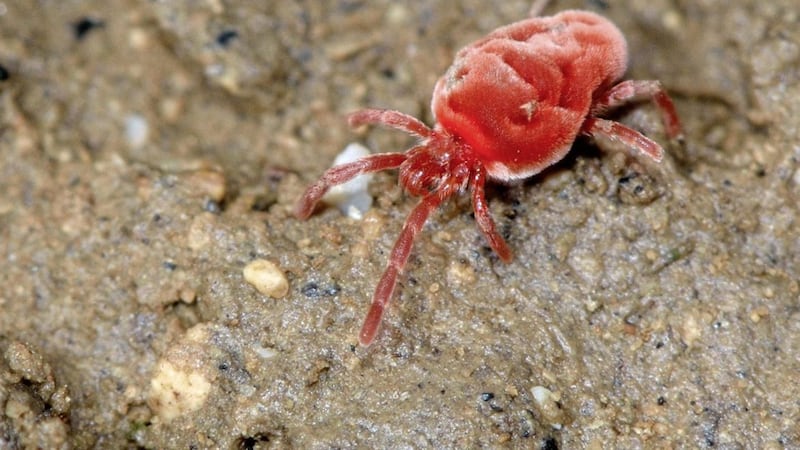A SOARING buzzard high in the sky last week prompted thoughts of the great biodiversity and layers of life which exist between the ground under our feet and the heights of the vast open sky above us.
Reflecting on this, my mind transported me back to a stifling hot Saturday morning in June 2013, when sitting in Courthouse Square of the Co Kildare university town of Maynooth, my eyes were drawn to dozens of tiny red mites zig-zagging across the contours of paving stone below. Their movement looked effortless and random, though I suspect there was an urgent purpose to their manoeuvres.
These red velvet mites, Trombidium holosericeum are extremely important to our environment as part of a community of soil arthropods which are critical in terms of decomposition rates in woodlands and in maintaining the structure of that ecosystem. By feeding on insects that eat fungi and bacteria, they help stimulate the decomposition process.
Over a thousand species worldwide, their common name of red velvet mite comes from the fine red hairs all over their body which resemble velvet and give them the ability to sense their surroundings. The bright red colour warns potential predators that they taste bad and so they have few enemies, excepting their own kind which may cannibalise them.
Although they taste terrible, some cultures have found a use for them in medicine, as oils from some species, like the giant red velvet mite, are used in traditional medicine to treat paralysis.
My moment of engagement with these minuscule, eight legged creatures was abruptly interrupted by horn blowing and a fist shaking driver, irate with a lady who had dared to walk across the path of his car at one of the town’s junctions. Looking on, I wondered what the diving swallows and house martens above might think of this behaviour.
Inside the grounds of Maynooth University itself, with its mighty beech trees and extensive gardens, I encountered more wildlife, demonstrating again the diversity of life around us. A male blackbird scuttled along the grass with food for its fledged chick. Close by, a grey squirrel scampered along before ascending a beech, with ease and with bushy tail in its wake.
Also of significance that day was the presence of an elderly lady with her Latvian carer who gently guided her through the gardens on a wheelchair. I noticed the lady gesturing towards some flowering, climbing roses and when brought close to them she leaned forward to smell and draw in their intense fragrance. She was visibly uplifted, the aroma like an elixir to her frail body.
When our paths met, she told me of her Co Tyrone roots and of leaving her native Plumbridge, by the Glenelly River in the Sperrins, decades before, to work, marry and live in Dublin. She had the countenance of someone who was happy and content with her life. This chance encounter and conversation made me think about her advanced years and her layers of living. A life with such longevity had many layers, I’m sure.
The variety of life between ground and sky is great and my observations around Maynooth that day were but a snapshot of such diversity, from the tiny invertebrate mites, aromatic roses and magnificent trees to the agile squirrel, blackbirds and airborne swallows.
These layers of life, I suspect, resembled in some ways the layers of living experienced by the lady in the wheelchair. Layers which involved joy, sadness, disappointment, hope and achievement. An eerie cry from the buzzard above brought me back to the present.



